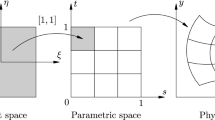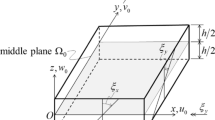Abstract
A new numerical manifold (NMM) method is derived on the basis of quartic uniform B-spline interpolation. The analysis shows that the new interpolation function possesses higher-order continuity and polynomial consistency compared with the conventional NMM. The stiffness matrix of the new element is well-conditioned. The proposed method is applied for the numerical example of thin plate bending. Based on the principle of minimum potential energy, the manifold matrices and equilibrium equation are deduced. Numerical results reveal that the NMM has high interpolation accuracy and rapid convergence for the global cover function and its higher-order partial derivatives.
Similar content being viewed by others
References
Shi, G. H. Manifold method of material analysis. Transactions of the 9th Army Conference of Applied Mathematics and Computing, Minneapolis, Minnesota 76 (1991)
Ma, G. W., An, X. M., and He, Li. The numerical manifold method: a review. International Journal of Computational Methods, 7(1), 1–32 (2010)
Li, S., Cheng, Y., and Wu, Y. F. Numerical manifold method based on the method of weighted residuals. Computational Mechanics, 35(6), 470–480 (2005)
Li, S. C. and Cheng, Y. M. Numerical manifold method and its applications in rock mechanics (in Chinese). Advances in Mechanics, 34(6), 446–454 (2004)
Zhang, G. X., Zhao, Y., and Peng, X. C. Simulation of toppling failure of rock slope by numerical manifold method. International Journal of Computational Methods, 7(1), 167–189 (2010)
Zhang, H. H., Li, L. X., and An, X. M. Numerical analysis of 2D crack propagation problems using the numerical manifold method. Engineering Analysis with Boundary Elements, 34(1), 41–50 (2010)
Wu, Z. J. and Wong, L. N. Y. Frictional crack initiation and propogation analysis using the numerical manifold method. Computers and Geotechnics, 39, 38–53 (2012)
Li, S. C., Li, S. C., and Cheng, Y. M. Enriched meshless manifold method for two-dimensional crack modeling. Theoretical and Applied Fracture Mechanics, 44(3), 234–248 (2005)
Kourepinis, D., Pearce, C., and Bicanic, N. Higher-order discontinuous modeling of fracturing in concrete using the numerical manifold method. International Journal of Computational Methods, 7(1), 83–106 (2010)
Gao, H. F. and Cheng, Y. M. A complex variable meshless manifold method for fracture problems. International Journal of Computational Methods, 7(1), 55–81 (2010)
Jiang, Q. H., Deng, S. S., Zhou, C. B., and Lu, W. B. Modeling unconfined seepage flow using three-dimensional numerical manifold method. Journal of Hydrodynamics, 22(4), 554–561 (2010)
Zhang, Z. R., Zhang, X. W., and Yan, J. H. Manifold method coupled velocity and pressure for Navier-Stokes equations and direct numerical solution of unsteady incompressible viscous flow. Computers and Fluids, 39(8), 1353–1365 (2010)
Song, J. S. and Ohnishi, Y. High order rectangular element of manifold method (in Chinese). Chinese Journal of Rock Mechanics and Engineering, 22(6), 932–936 (2003)
Luo, S. M., Zhang, X. W., Lv, W. G., and Jiang, D. R. Theoretical study of three-dimensional numerical manifold method. Applied Mathematics and Mechanics (English Edition), 26(9), 1027–1032 (2005) DOI 10.1007/BF02507721
Lin, S. Z., Qi, Y. F., and Su, H. D. Improved local function of numerical manifold method and its application (in Chinese). Journal of Yangtze River Scientific Research Institute, 23(6), 55–58 (2006)
Taylor, R. L., Zienkiewicz, O. C., and Onate, E. A hierarchical finite element method based on partition of unity. Computer Methods in Applied Mechanics and Engineering, 152(1–2), 73–84 (1998)
Cai, Y. C., Zhuang, X. Y., and Augarde, C. A new partition of unity finite element free from the linear dependence problem and possessing the delta property. Computer Methods in Applied Mechanics and Engineering, 199(17–20), 1036–1043 (2010)
Li, S. C. and Cheng, Y. M. Meshless numerical manifold method based on unity partition (in Chinese). Chinese Journal of Theoretical and Applied Mechanics, 36(4), 496–500 (2004)
Gao, H. F. and Cheng, Y. M. Complex variable numerical manifold method for elasticity (in Chinese). Chinese Journal of Theoretical and Applied Mechanics, 41(4), 480–488 (2009)
Sevilla, R., Fernandez-Mendez, S., and Huerta, A. NURBS-enhanced finite element method (NEFEM). Archives of Computational Methods in Engineering, 18(4), 441–484 (2011)
Piegl, L. and Tiller, W. The NURBS Book, 2nd ed., Springer, London, 81–110 (1996)
Barber, J. R. Elasticity, 2nd ed., Klüwer Academic Publishers, New York, 33–39 (2004)
Author information
Authors and Affiliations
Rights and permissions
About this article
Cite this article
Wen, Wb., Jian, Kl. & Luo, Sm. 2D numerical manifold method based on quartic uniform B-spline interpolation and its application in thin plate bending. Appl. Math. Mech.-Engl. Ed. 34, 1017–1030 (2013). https://doi.org/10.1007/s10483-013-1724-x
Received:
Accepted:
Published:
Issue Date:
DOI: https://doi.org/10.1007/s10483-013-1724-x




